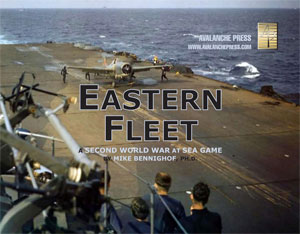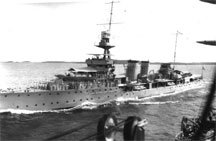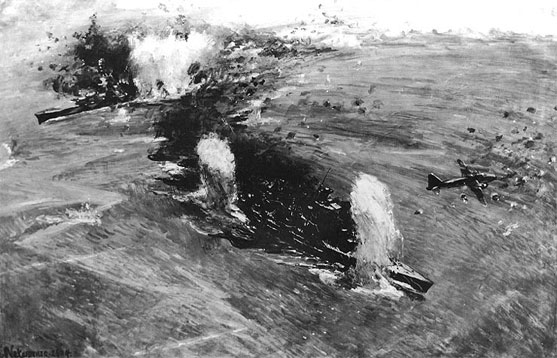| Britain’s Eastern Fleet
By Mike Bennighof, Ph.D.
July 2020
Put not your trust in princes, nor in the son of man, in whom there is no help.
Psalm 146:3
 For the first two years of World War II,
the Royal Navy faced significant challenges
in European waters. While British naval strength
seriously outweighed that of Germany and Italy,
in the North Atlantic the huge expanses of
open water required huge forces to adequately
patrol against German raiders. And British
ships operating in the Mediterranean against
the Italians were exposed to constant attack
by enemy land-based aircraft, plus the efforts
of the Italian surface fleet. For the first two years of World War II,
the Royal Navy faced significant challenges
in European waters. While British naval strength
seriously outweighed that of Germany and Italy,
in the North Atlantic the huge expanses of
open water required huge forces to adequately
patrol against German raiders. And British
ships operating in the Mediterranean against
the Italians were exposed to constant attack
by enemy land-based aircraft, plus the efforts
of the Italian surface fleet.
That left little strength to deploy against
potential adversaries, with every ship needed
to combat real ones. The Far East Station,
headquartered in Singapore and responsible
for security in the Indian Ocean, spent the
first years of the war hunting enemy commerce
raiders and supporting the invasions of Iraq,
Iran and Italian Somaliland. Its strength
varied, usually including a few cruisers,
most of them veterans of the First World War,
and the small aircraft carrier Hermes.

Eastern Fleet workhorse, the light cruiser Dragon.
|
By the summer of 1941, British leaders believed
a Japanese attack had become inevitable; the
only variable was its timing and initial targets.
Admiral of the Fleet Sir Dudley Pound, the
First Sea Lord, advocated sending a squadron
of the old battleships then engaged on convoy
escort to Ceylon as a deterrent. Prime Minister
Winston Churchill, never one to doubt his
self-anointed expertise, called the old ships
“floating coffins” and argued
instead for a small, modern striking force
including at least one modern fast battleship
and an aircraft carrier. Both opposition leader
Clement Atlee and Foreign Minister Anthony
Eden backed Churchill’s assessment.
Compromise was achieved by approving both
plans. Four ancient battleships of the Royal
Sovereign class headed to the Indian Ocean.
They had not been rebuilt like most Great
War battleships still serving in the Royal Navy and other fleets,
and had seen hard service in the North Atlantic
protecting convoys from German raiders. They
could barely make 18 knots and faced a constant
threat of serious breakdowns — something
that could not easily be repaired at Ceylon.
They did each carry eight 15-inch guns, but
their low speed and inadequate anti-aircraft
protection would have made them a liability
in any fleet encounter.
Churchill’s version, known initially
as Force Orange, included the battleship Prince
of Wales, the battle cruiser Repulse and the aircraft carrier Indomitable.
To command the force, and by extension the
Eastern Fleet which would be declared operational
once the ships arrived at Singapore, Churchill
pushed his personal friend Rear Admiral Sir
Tom Phillips on the Sea Lords. Phillips, vice
chief of the Naval Staff, had not been to
sea since 1917. The diminutive “Tom
Thumb” had a scornful attitude toward
both the Japanese and the threat to surface
warships posed by aircraft of any nationality.
When Indomitable ran aground in the
West Indies, he did not consider it a major
loss.
Two other major units were potentially available,
and would join the Eastern Fleet in January
1942. When the Japanese attacked Pearl Harbor,
the battleship Warspite was at Bremerton,
Washington, undergoing major repairs following
damage suffered during the evacuation of Crete
in the summer of 1941. The carrier Formidable was at Norfolk Naval Shipyard for the same
purpose.
Phillips arrived at Singapore with on 2 December
1941, with Prince of Wales and Repulse and two destroyers. One undersized heavy cruiser,
a handful of Great War-era light cruisers
and some destroyers were already on station.
“Tom Thumb” formally took command
of the Eastern Fleet on 8 December, and held
it for less than 48 hours.

Japanese wartime painting of the end of British
sea power.
On learning of Japanese landings in northern
Malaya and southern Thailand, Phillips decided,
in the best tradition of the Royal Navy, to
go “right at them.” He steamed
north with all four of his newly-arrived ships
plus two elderly destroyers from Singapore
station (both of which he had to send back
due to fuel and maintenance problems). He
narrowly missed intercepting the Japanese,
but instead was spotted by Japanese aircraft
on the 10th. Both British capital ships sank under
a rain of bombs and torpedoes.
Command passed to Admiral Sir Geoffrey Layton,
who came under the Allied naval command “ABDAfloat”
and brought his surviving cruisers to Java
to join Dutch, American and Australian ships
there. The Japanese crushed ABDA and by March
the Eastern Fleet’s remnants (chiefly
its headquarters personnel, as most of its
cruisers and destroyers had either been sunk
or diverted to vital convoy escort missions)
had relocated to Trincomalee, Ceylon. There,
Vice Admiral Sir James Somerville, who had
commanded the famous Force H at Gibraltar,
took command and soon faced a serious challenge.
Somerville had the four ancient battleships
sent by Sir Dudley the previous summer, Warspite and Formidable newly arrived from the
United States, and the just-repaired Indomitable. Warspite became his flagship, as he’d
commanded her in the 1920s. From the old Far
East Station he also inherited the heavy cruisers Cornwall and Dorsetshire, which
had spent the war patrolling the Indian Ocean
for surface raiders, and the small, aging
carrier Hermes. Several old light cruisers
from Layton’s force rounded out the
fleet.

Hermes sinks, 9 April 1942.
|
Two days after Somerville took command, he received
word of a major Japanese incursion into the
Indian Ocean. Admiral Chuichi Nagumo brought
five fleet carriers on a raid against Ceylon.
Dividing his force into a “fast”
and a “slow” group, Somerville cruised
south of the big island but, probably fortunately
for the Royal Navy, did not make contact with
the Japanese carrier force. The Japanese did
spot Hermes and the two heavy cruisers,
and promptly sank all three. At times the fleets
were no more than 200 miles apart, with Somerville
trying to keep his distance by day and close
for a night surface action. The Japanese failed
to locate the new British “secret base”
at Addu Atoll and
the Eastern Fleet moved to a new anchorage on
the Kenyan coast near Mombasa to keep out of
range of the Japanese carriers.
In April and May, parts of the Eastern Fleet
helped cover Operation Ironclad, the invasion
of Madagascar. Afterwards, it remained a “fleet
in being” until early 1944, when the
British began to contemplate resuming active
operations in the theater. The defeat of Italy
and the destruction of most of German’s
surface fleet had freed many warships for
new missions. When an American task force
arrived for some practical demonstrations
of the new style of carrier warfare, the Eastern
Fleet went on the offensive.
Click here to order Eastern Fleet!
Sign up for our newsletter right here. Your info will never be sold or transferred; we'll just use it to update you on new games and new offers.
Mike Bennighof is president of Avalanche Press and holds a doctorate in history from Emory University. A Fulbright Scholar and NASA Journalist in Space finalist, he has published eleventy-million books, games and articles on historical subjects.
He lives in Birmingham, Alabama with his wife, three children, his dog Leopold.
|
